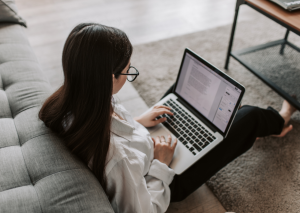With more of us doing screen-based work in non-professional settings, physiotherapist Clare Dingle shares some tips for creating a safe and comfortable workspace.
For most fitness professionals, being deskbound is not usually a problem. These have not been usual times however, and many trainers and instructors have been finding themselves spending hours crouched over laptop screens on their sofas or kitchen tables. Cue sore necks, shoulders and upper backs.
While gyms are reopening and clients and members returning, this period has highlighted the need to have home-based workspaces that do not negatively impact us physically.
Here are some top tips to create a more ergonomic workstation that makes any time spent working from home a little less uncomfortable.
1. Keep all angles at 90 degrees
If you have a height-adjustable desk and desk chair, make sure you adjust them to a 90-degree angle to avoid slouching. Your knees, hips, and back should also be of utmost priority.
2. Flat feet
Whether you put them on the ground or use a footrest, you should keep your feet flat. This will help to maintain the 90-degree angle.
3. Neutral positioning
If you’re working between two screens, make sure that you are positioned to face the middle where they connect, maintaining your head in a straight and neutral position.
4. Posture
Avoid forward head and neck posture: tuck your chin in, lengthen your neck and bring your head back into alignment with your shoulders. Imagine a helium balloon pulling you up.
5. Ergonomic height
Set your computer so that you are at eye level with the top third of the screen. A laptop stand, such as Twelve South’s HiRise or Curve for MacBook, can position your device at an appropriate height, ensuring that you’re not straining your neck by looking up or down.
6. Mouse and keyboard
Try keeping these close to the body so that you aren’t reaching out to use them. If possible, use a separate keyboard, monitor and mouse.
7. Movement
Keeping a cup of water beside you rather than a large drink bottle will encourage you to get up for a refill and thereby have a quick bout of incidental activity! Aim to get up and move around the room every 20 to 30 minutes to avoid joint stiffness.
8. Stretch
Stretches should involve anything opposing the position you were sitting in. This includes elbow extensions, knee extensions, neck stretches and wrist rotations.
9. Handheld devices
Use earphones instead of holding the phone to the ear. It becomes increasingly difficult to multi-task, so ensure that you’re keeping the phone on the table, allowing you to type and eliminating the habit of bending your neck.
10. Exercise
As a fitness professional, you know how important this is for every aspect of life, but in terms of desk-based work, you specifically need good general strength and flexibility in your neck, shoulders, back, and abdominal muscles to support good posture.
11. Breathing exercises
To avoid tension building in your neck and upper shoulder muscles, take three deep breaths down into your diaphragm and belly every 20 to 30 minutes, soften your shoulders and draw your shoulder blades back and down.
12. Routine
Maintaining a consistent routine needs to be a priority. Balance your daily schedule by factoring in breaks for eating and getting fresh air.
Clare Dingle, B.Phty
Clare is a physiotherapist with Women in Focus Physiotherapy based in Sydney, and occupational therapist for Twelve South, which designs accessories to help people create ergonomic and stylish working environments. twelvesouth.com
Information sourced from Australian Fitness Network



